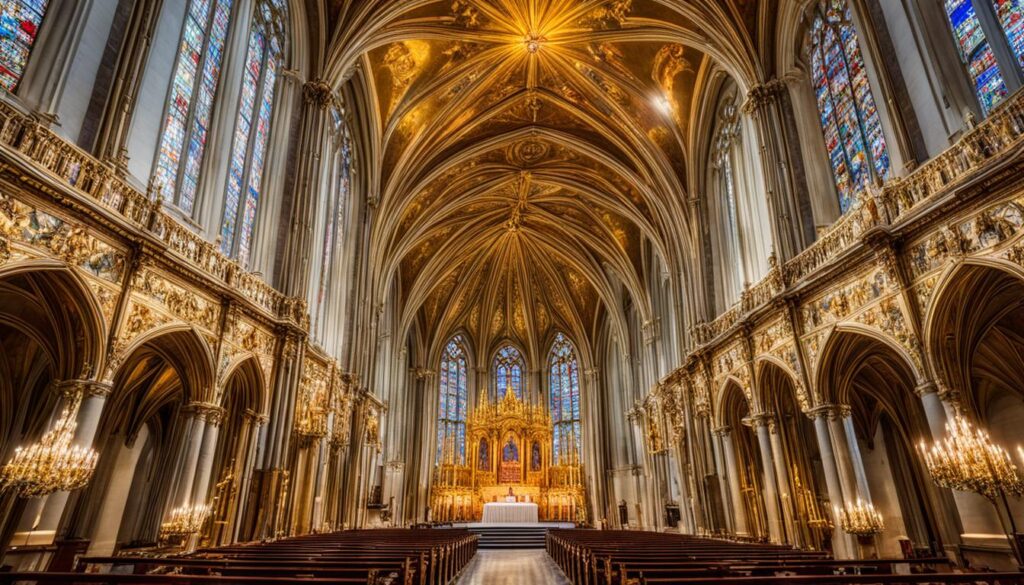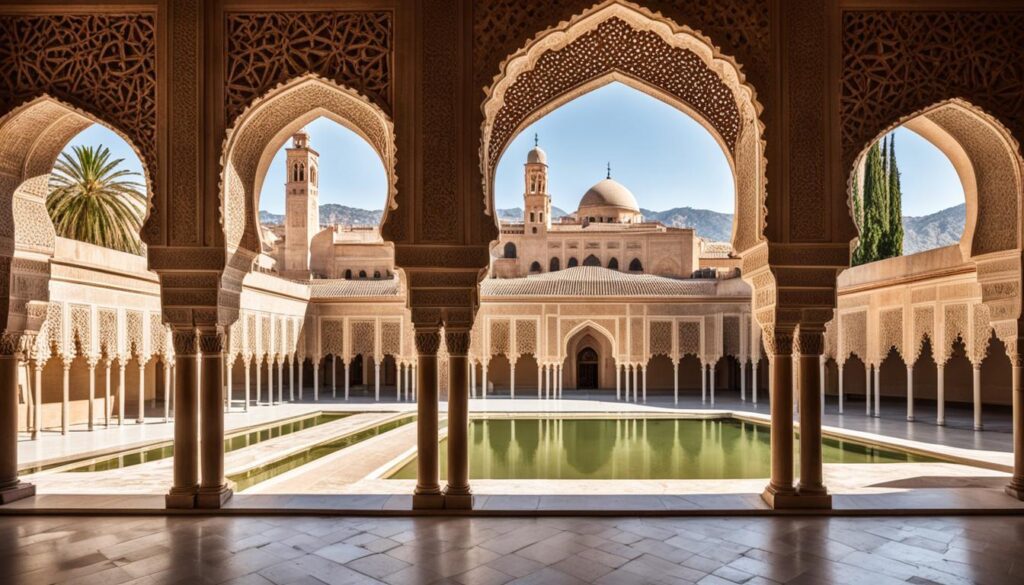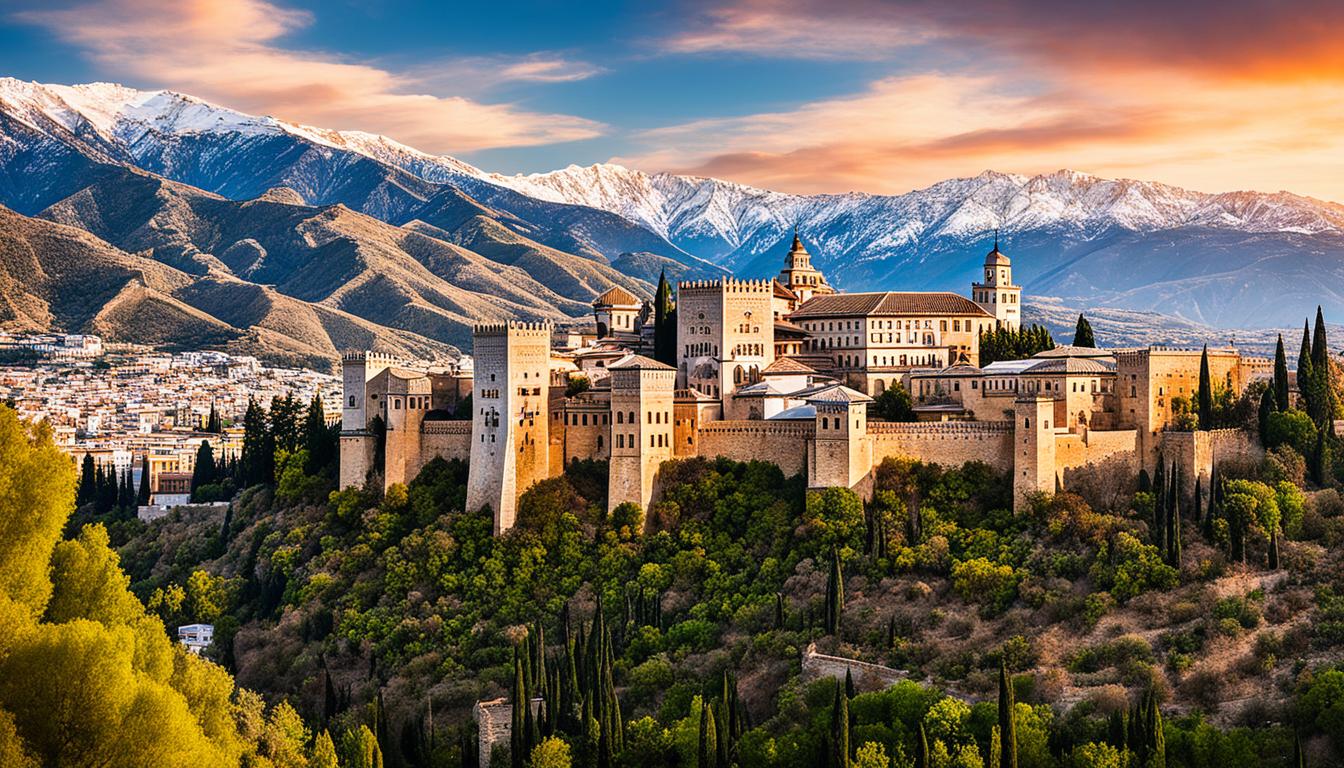Granada is a city that holds the legacy of two important times in its history. The Nasrid era saw the Alhambra as a key center of power. Later, the Catholic Monarchs brought many churches, convents, and Renaissance palaces to the city. These landmarks show off Granada’s rich history, making it a must-see for visitors.
Having a local guide can make exploring Granada’s historic sites even more special. They can share stories and insights that bring the past to life.
Key Takeaways
- Granada is a city rich in historic sites that showcase its Nasrid and Catholic Monarchs’ legacies.
- The Alhambra, a Moorish palace, is Granada’s most visited monument and a prime example of Islamic architecture.
- The city’s historic neighborhoods, such as the Albaicín, offer a glimpse into the city’s Moorish past.
- Granada’s Renaissance cathedrals and chapels are architectural masterpieces that reflect the influence of the Catholic Monarchs.
- Exploring Granada’s historic sites with a local guide can greatly enhance the overall experience.
The Alhambra: Crown Jewel of Moorish Architecture
The Alhambra, Granada’s top attraction, is the highlight of Moorish architecture. This stunning palace complex was once the home of the Nasrid dynasty. It shows the beauty and skill of Moorish art in Spain.
Unraveling the Secrets of the Nasrid Palaces
The Nasrid Palaces are at the Alhambra’s heart. They are famous for their detailed decorations and large courtyards. Visitors can see halls filled with beautiful calligraphy, tilework, and fountains. These show the Nasrid dynasty’s architectural skill.
The Nasrid Palaces can only be visited during an allotted 30-minute period. It’s important to plan ahead and get tickets early. They often sell out three months before.
The Generalife Gardens: An Oasis of Tranquility
The Generalife Gardens offer a peaceful escape from the palace’s grandeur. With fountains, green terraces, and shaded paths, they mix Moorish architecture with nature. Visitors can enjoy the calm here.
The Generalife includes a water courtyard and surrounding gardens. This place offers a nice change from the Nasrid Palaces’ luxury.
“The Alhambra is one of the most visited places in Spain and a true UNESCO World Heritage Site.”
The Alhambra shows off Granada’s history and Moorish architecture. It draws visitors from all over the world. It’s a symbol of the Nasrid dynasty’s legacy and Granada’s rich culture.
The Albaicín: Granada’s Captivating Moorish Quarter
The Albaicín neighborhood is in the heart of Granada, showing off the city’s Moorish past. Its narrow, cobblestone streets take you back in time. Here, you can see the Moorish architecture and feel the history that made this place special.
Exploring the Labyrinth of Narrow Streets
The Albaicín was once a key area for Granada’s Moorish people. It was full of life during the Nasrid dynasty, with over forty thousand people and thirty mosques. But over time, the Moorish people left, and by the 17th century, it had changed a lot.
Now, the Albaicín still draws in visitors with its winding streets, white buildings, and historic spots. You can visit the Casa de Zafra, an Arab house turned museum. It tells the story of the Albaicín’s Moorish past.
San Nicolás Mirador: Breathtaking Views of the Alhambra
The San Nicolás Mirador is a famous spot in the Albaicín. It’s on a hill and gives amazing views of the Alhambra. This palace is a symbol of Moorish influence on Granada’s culture and history.
The Albaicín is a place you must see to really get into the spirit of Granada’s Moorish heritage. It’s full of Moorish architecture, historic sites, and stunning views.
The Cathedral of Granada: Renaissance Marvel
In the heart of Granada, Spain, the Cathedral of Granada is a key part of the city’s history and architecture. It was built by the Catholic Monarchs. This marks a big change in Granada’s history, showing the rise of Christianity after Moorish rule.
Admiring the Exquisite Spanish Renaissance Architecture
The cathedral started in 1523 with Charles V’s support. Its design mixed different styles over nearly two centuries. The front of the cathedral shows off Spanish Renaissance beauty, combining Gothic, Renaissance, and Baroque styles.
Inside, you’ll find five big naves filled with sculptures, stained-glass windows, and beautiful choir stalls. Near the cathedral is the Royal Chapel. It has the tombs of Queen Isabella I and King Ferdinand II, making it even more special.
“The Granada Cathedral remains a popular tourist attraction, drawing visitors from around the world to admire its architecture and learn about its history.”
Now, the cathedral is a key spot for culture and faith. Tours let you explore its history and design. They give a peek into Granada’s lasting cultural and religious role.
Seeing the Granada Cathedral is a must when visiting this magical Andalusian city. Its stunning Renaissance look, deep history, and cultural importance make it a symbol of Granada’s spirit. It invites visitors to experience the city’s rich past and present.
The Royal Chapel: Resting Place of the Catholic Monarchs
In the heart of Granada, the Royal Chapel is a key part of the city’s history. It’s where the catholic monarchs who greatly influenced Granada’s history rest. This sacred place is a must-see for anyone interested in granada history.
The Royal Chapel was built from 1505 to 1517. It was made to be the final home of Queen Isabella I and King Ferdinand, the famous catholic monarchs. Today, it’s a place of great architectural and historical importance, drawing visitors from all over to see the royal chapel granada.
The inside of the chapel is stunning, with a Gothic ribbed vault and four side chapels. These form a Latin cross shape. The tombs of Isabella and Ferdinand are near the altar, showing their deep respect and faith.
“The Royal Chapel became a top tourist attraction in Granada in the latter half of the twentieth century.”
Not just for the Catholic Monarchs, the Royal Chapel also holds the remains of other royals like Joanna of Castile and Philip I of Castile. You can see Queen Isabella’s crown, sceptre, and jewellery box, and King Ferdinand’s sword in the Sacristy-Museum next door.
The Royal Chapel honors the lasting impact of the catholic monarchs and the rich granada history. It continues to draw visitors from all over the world.

Bañuelo: Granada’s Ancient Arab Bathhouse
In the heart of Granada’s Albaicín neighborhood, the Bañuelo is a key piece of history. This 11th-century Arab bath, or hammam, is a top spot for seeing Moorish architecture in Spain. It shows us what life was like in Granada during the Islamic era.
King Balis of the Zirid dynasty built the Bañuelo with help from his Jewish advisor, Samuel ibn Naghrillah. This hammam shows off Moorish design and how they built public baths. It has an entrance hall, cold room, warm room, and hot room.
After Granada was conquered by Christians, the Bañuelo was mostly forgotten. People saw it as similar to brothels. But in 1918, it was named a National Monument. Thanks to architect Torres Balbas, it was restored, saving a big part of Granada’s history and Islamic heritage.
Now, the Bañuelo is open for everyone to see, free of charge. It lets visitors see the beauty of Moorish architecture and design. The calm inside and its well-kept look make it a special place to learn about Granada’s history.
“The Bañuelo of Granada is one of the oldest, most important, and complete Arab public baths in Spain, dating back to the 11th century.”
Granada’s Albaicín also has two other medieval hammams. The Arab bath of Hernando de Zafra and the Arab baths on Calle del Agua were built in the late 12th or early 13th century. The Comares Palace Arab baths, from the 14th century, were recently fixed up and opened again.
For a modern take on Moorish baths, Granada has places like Hammam Al Andalus and Baños Elvira. These baths offer massages and tea, letting visitors enjoy the Islamic heritage in a new way.
The Alcaicería: Granada’s Historic Silk Market
In the heart of Granada, the Alcaicería is a symbol of the city’s deep Moorish history and active trade. Built by Yusuf I, it was a key spot for merchants and the storage of goods. It’s the oldest Arab monument in Granada.
The Alcaicería has narrow streets filled with history. Once, over 200 shops bustled here, making it a key spot for alcaiceria granada, moorish architecture, granada history, and trade and commerce. Now, it shows Granada’s lively spirit, giving visitors a peek into its past.
Walking through the Alcaicería, you’ll see Arabic-inspired crafts like fajalauza ceramics and taracea woodwork. You’ll also find ethnic clothes, knick-knacks, and souvenirs. Each item tells a story of Granada’s history.
For a quieter visit, go early in the morning or late in the evening. Bargaining is common here. It lets you negotiate prices and discover special items among the stalls.
The Alcaicería is perfect for those interested in history, Moorish architecture, or unique crafts. It’s a key spot for anyone wanting to explore Granada’s essence.
granada historic sites: Unveiling the City’s Islamic Heritage
In the heart of southern Spain lies the historic city of Granada. It’s known for its rich Islamic heritage that has drawn visitors for centuries. The Alhambra and other Moorish sites show the city’s past. They invite travelers to explore the cultural legacy that defines Granada.
The Alhambra is the top site in Granada, a UNESCO World Heritage Site. It’s a palace from the Nasrid dynasty, famous for its Arabic inscriptions and beautiful gardens. The Generalife Gardens are a peaceful spot in the midst of grandeur.
| Landmark | Significance | Annual Visitors |
|---|---|---|
| The Alhambra | Epitome of Moorish architecture | Over 2 million |
| El Bañuelo | Preserved 11th-century Arab bathhouse | Thousands |
| Madrasah Yusufiyya | Blends Islamic and Spanish styles | Hundreds of thousands |
The Albaicín quarter is a maze of narrow streets and whitewashed houses. It shows Granada’s Moorish past. Visitors can find hidden spots like the San Nicolás Mirador. It has great views of the Alhambra and the city.
“The Alhambra in Granada draws over two million visitors annually, making it the most popular attraction in Spain within Islamic historic sites.”
Granada’s Islamic heritage is also seen in the Sacromonte Caves, the Alcaicería silk market, and the Madrasa. The Madrasa was a key Islamic university, a place of learning and scholarship.
Granada’s Islamic heritage still draws visitors today. It offers a mix of architectural wonders, cultural traditions, and historical insights. Exploring the Alhambra or the Albaicín lets travelers discover the city’s lasting Islamic legacy. It’s a chance to experience a unique cultural journey.
The Madraza: Granada’s Pioneering Islamic University
Granada’s rich culture is shown in the Madraza, a key Arab university from the Nasrid era. Sultan Yusuf I started it in 1349. This place lets us see the deep learning and culture of Granada under the Nasrids.
Delving into the Realm of Moorish Education
The Madraza, or Madrasah Yusufiyya, was a groundbreaking school. It taught subjects like medicine, calculus, astronomy, geometry, and logic. This place was key in shaping Granada’s intellectual scene, helping raise scholars and thinkers.
Through time, the Madraza changed, showing Granada’s history shifts. After the Catholic Monarchs took over, it became a Christian college. Yet, the University of Granada, started in 1531, kept the Madraza’s learning spirit alive, keeping Granada a learning hub.
“The University of Granada is ranked as the 326th best university in the world according to the Shanghai Academic Ranking of World Universities, showcasing the enduring significance of this institution in the realm of higher education.”
Now, the Madraza is a symbol of Granada’s Moorish past. It’s a place for visitors to see the city’s Islamic learning traditions. Its stunning Nasrid-style design makes exploring Granada’s madraza granada, moorish architecture, granada history, and islamic education even more special.

The Sacromonte Caves: Unique Abodes and Flamenco Legacy
The Sacromonte Caves sit high on Sacromonte Hill in Granada. They have a special charm and a deep cultural history. Since the 16th century, they’ve been home to gypsies, artists, and bohemians. This gives a peek into Granada’s past.
The caves are key to Granada’s flamenco tradition. They helped keep this passionate music alive. The area is where Zambra, a unique flamenco style, was born. It’s a big part of the region’s culture.
At the Cuevas del Sacromonte Museum, you can dive into the caves’ history. It shows how the cave-dwelling community lived. With interactive exhibits and tours, it feels like stepping back in time.
There’s more to see in Sacromonte than the museum. The Sacromonte Abbey and its courtyard are peaceful spots. And you might hear flamenco music, showing the art form’s power.
For a true taste of Granada’s culture, visit the Sacromonte Caves. This place keeps the city’s Moorish history alive. It also honors the flamenco music that’s a big part of sacromonte caves, granada history, cultural heritage, and flamenco music.
Monasterio de San Jerónimo: A Blend of Architectural Styles
In the heart of Granada, the Monasterio de San Jerónimo is a key part of the city’s history and architecture. Founded in 1504, it combines Baroque and Renaissance styles. This makes it a place that takes you back in time.
Admiring the Intricate Baroque and Renaissance Details
The building started in 1504, finishing the main chapel by 1522. Over the years, it has been restored, including a big project in the early 1900s. Now, its Baroque and Renaissance details are stunning, showing off Granada’s history.
The monastery has two cloisters, each with beautiful gardens. The first courtyard has thirty-six semicircular arches with detailed shields, showing Baroque style. The tower, rebuilt in the 1980s, adds to the monastery’s tall and impressive look.
Visitors can see the monastery’s history and amazing artwork, like the main altarpiece. This piece was restored in the early 2000s. The monastery’s role in baroque art and architectural styles shows Granada’s lasting cultural value.
| Year | Event |
|---|---|
| 1504 | The Monasterio de San Jerónimo was founded in Santa Fe outside the city of Granada. |
| 1504 | Construction of the current buildings in Granada began. |
| 1522 | The main chapel was completed. |
| 1916-1920 | The monastery underwent restoration by the State. |
| 1980s | The monastery’s tower was re-erected, with the project completed in 1989. |
| 2022 | The image of “Our Lady of Solitude” was crowned by Pope Francis on November 1. |
The Monasterio de San Jerónimo is a key example of Granada’s architectural styles and granada history. It draws visitors with its detailed baroque art and Renaissance design. A visit here is a must for anyone wanting to see the cultural beauty of this Andalusian city.
Conclusion: Embracing Granada’s Rich Cultural Tapestry
Granada’s historic sites, like the Alhambra and hidden Moorish gems, tell a captivating story of the city’s past. These sites let visitors dive into Granada’s rich cultural heritage. They reveal the history that has made this place special.
By exploring the city’s architecture and Islamic heritage, travelers can understand Granada’s unique identity. They can see the lasting impact of its history.
The Moorish architecture of the Alhambra and the Albaicín neighborhood show Spain’s Moorish history. The Granada Cathedral and Royal Chapel highlight the city’s mix of cultures. From ancient baths to lively festivals, Granada’s cultural tourism experiences are unforgettable.
As you leave Granada, remember the memories and the deep understanding of its history. This city’s mix of Moorish and Christian legacies is unique. Let it inspire your future travels and personal growth.

